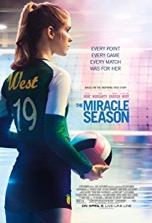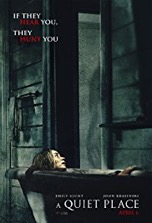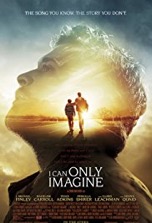April 2018
The Miracle Season (PG)
23/04/18 00:39 Filed in: 2018

Starring: Helen Hunt
April 2018
Warning! This is NOT a movie review. This is a critique of the film. Intended to initiate a dialogue, the following analysis explores various aspects of the film and may contain spoilers. Views are my own and elaborate on comments that were originally tweeted in real time from the back row of a movie theater @BackRoweReviews. For concerns over objectionable content, please first refer to one of the many parental movie guide websites. Ratings are based on a four star system. Happy reading!
The Premise:
A high school volleyball team must overcome the loss of their team captain in order to repeat as state champions.
The Evaluation:
“Have you ever met someone who could make anything into an adventure?”
The movie’s opening line is the perfect introduction to its central character, the vivacious captain of a women’s high school volleyball team, Caroline “Line” Found (Danika Yarosh). Caroline’s ebullient personality is infectious; she makes friends with everyone she meets, even players on opposing teams. Coming off an emotional state championship win the year before, Caroline and her teammates have aspirations of repeating. After rolling past their first opponent, another championship seems all but assured. Then comes the tragic night when the news of Caroline’s fatal driving accident sweeps through the community like wildfire. The grief-stricken volleyball team’s hopeful quest for a second state championship comes to a devastating standstill. But with motivation from their inspiring coach and a resolve born out of their desire to honor their fallen friend, the players channel their anger and guilt into one all-consuming goal: “Win for Line.” Based on the true account of how the Iowa City West High School women’s volleyball team won the state championship against all odds in 2011, The Miracle Season is a strong character piece that also features some pulse-pounding action during several volleyball tournaments. Season is a deeply moving story about finding the courage to carry on after a tragic loss. Despite its similar theme to We Are Marshall (2006) and similar plot to Hoosiers (1986), Season is an inspirational sports movie where the miracle on the court pales in comparison to the one that takes place inside the hearts of the grieving players and community.
The Breakdown:
Directing- The man responsible for keeping the character moments meaningful and the volleyball game sequences taut with excitement is director Sean McNamara, who also helmed the tragedy-turned-victory sports film Soul Surfer (2011).
Acting- The cast is an eclectic mix of established and new actors. Big screen notables like Helen Hunt (who also starred in Surfer) and William Hurt are joined by some truly fine young actors like Yarosh (Heroes Reborn) and Erin Moriarty (Jessica Jones). Jason Gray-Stanford (Monk) also delivers a memorable performance as assistant coach, Scott Sanders.
Story- Ensuring that the sports elements didn’t run away with the story are screenwriters David Aaron Cohen and Elissa Matsueda. Cohen was already familiar with the genre, having co-written Friday Night Lights (2004).
Costumes/Make-up- Standard, skimpy volleyball outfits, but the rest of the movie’s wardrobe is appropriate.
Cinematography- The locations surprisingly resemble the Iowan countryside even though the movie was filmed in Vancouver, British Columbia, Canada. These locations add a great deal to the team’s road trips, especially during the snow angel scene.
Music- The evocative trumpet arrangement in Roque Banos’ score perfectly captures the film’s bittersweet aspects. The crowd singing Neil Diamond’s “Sweet Caroline” at the end of the movie is a nice touch.
Visual FX- NA
Production Values- The various production elements are respectable, especially when considering the movie’s modest budget. The school/gym interiors are authentic and the Found’s house and barn sets are functional and homey.
Movie Magic- If you enjoy high-energy sports flicks with quick cuts that amp up the action, this movie is for you. Although the story does get a tad Hallmark-y at times, it’s a clean, inspirational film that spotlights one of the more remarkable stories to have come out of the world of high school sports in recent years.
Rating: 3 out of 4 stars
A Quiet Place (PG-13)
22/04/18 02:25 Filed in: 2018

Starring: Emily Blunt
April 2018
Warning! This is NOT a movie review. This is a critique of the film. Intended to initiate a dialogue, the following analysis explores various aspects of the film and may contain spoilers. Views are my own and elaborate on comments that were originally tweeted in real time from the back row of a movie theater @BackRoweReviews. For concerns over objectionable content, please first refer to one of the many parental movie guide websites. Ratings are based on a four star system. Happy reading!
The Premise:
A family struggles to survive in a post-apocalyptic world where making the slightest noise can attract the attention of carnivorous creatures.
The Evaluation:
Normally a movie inundated with this much hype would collapse under the weight of the insurmountable expectations placed upon it. Since the trailer looked so intriguing, it comes as a great relief that A Quiet Place delivers on its promise—it’s a thought-provoking, spine-tingling good time. John Krasinski does triple duty (actor, writer and director) on this horror/thriller/sci-fi hybrid. The linchpin to the film’s success is its premise. In a dystopian world, aliens have invaded Earth and wiped out a large percentage of the human population. The good news is that the creatures are blind. The bad news is that they have super-sensitive hearing. To safeguard against being attacked, the Abbott family learns to communicate by speaking in hushed tones or using sign language. Though the movie is disciplined at following the strictures of its self-imposed rules, the concept certainly has its fair share of nitpicks. First, how is it possible to run a farm without making any noise? Also, when approaching humans, wouldn’t the creatures hear breathing, however controlled, or a rapidly beating heart (yes, what we learn during the waterfall scene significantly weakens this argument, but the criticism holds up when the creatures are at close range)? Raising kids under such strict conditions would be a monumental task—no frolicking in the front yard or roughhousing in the living room. And, as if that wasn’t hard enough, how in the world would you bring up a baby in such an environment (a similar grievance was raised by fans of The Walking Dead over Rick’s baby, Judith, being raised during the zombie apocalypse)? As the creature closes in on Blunt and her baby, and later, Blunt and her daughter, it can’t quite locate the humans in either instance. So then, are we to believe that these blind creatures also have no sense of smell? These minor gripes are forgivable. What mars the movie most is the climactic sacrifice, which could’ve been prevented if one of the characters had been as quick on the uptake as the audience. Fortunately, this is the movie’s only instance of flaccid plotting. There are many parallels between this film and Signs (2002). Aside from both movies featuring an alien invasion storyline, cornfield encounter and farmhouse showdown, the aliens in both movies have one fatal weakness—a plot device borrowed from the original The War of the Worlds (1953). Also pilfered from Worlds is the “aliens travel in trios” concept, which is particularly relevant here since the minimum number of points required to triangulate the location of a sound is three. Though the movie’s creatures are reminiscent of the ones in Alien (1979), they do have a unique design (See: Visual FX). Despite its many similarities to other horror films, Quiet features one of the most clever and original concepts in the history of the genre. So, will this Signs meets Aliens post-apocalyptic chiller stand the test of time? Time will tell. One thing’s for certain, in Krasinski’s world, everyone can hear you scream.
The Breakdown:
Directing- Krasinski’s craft is impeccable—he channels Hitchcock and Shyamalan to great effect. Some of the moments Krasinski creates are utterly terrifying, like the baby in the basement sequence.
Acting- Emily Blunt mesmerizes in a physically demanding role—she had to stand in water for a good portion of the movie. Blunt effectively conveys a range of emotions without speaking for most of the movie. Likewise, Krasinski delivers a marvelously measured performance—the scene where he slowly raises his finger to his lips, signaling others to remain silent, will go down as an iconic image in cinema history. He’s come a long way from his days as Jim Halpert on The Office. The child actors (Millicent Simmonds and Noah Jupe) also do excellent work in challenging, largely non-speaking roles.
Story- A difficult screenplay to write and execute, but handled with expert skill by Bryan Woods, Scott Beck and Krasinski. With a dearth of dialog, most of the action had to be described in detail in the script or storyboarded.
Costumes/Make-up- Functional and appropriate for the world the characters live in.
Cinematography- Charlotte Bruus Christensen does a superb job of capturing the pastoral landscape and the action sequences inside and outside the farmhouse. There are many memorable scenes in the movie, particularly those involving the bridge, silos, fields and basement. The sweeping shots atop the silos help to establish the terrain and atmosphere of the agrarian world the characters have been relegated to. The rows of white or red lights also make a striking visual.
Music- The film’s eerie mood is further enhanced by Marco Beltrami’s ethereal score which, like the characters for most of the movie, goes largely unnoticed.
Visual FX- Truly astounding creature FX—the next iteration of the Alien creature is jaw-dropping, literally. The design of the creature’s malleable head is ingenious and sets up the movie’s most memorable visual during the climactic confrontation. These FX should be a shoo-in for an Oscar nod.
Production Values- Certainly not a lavish production, since most of the movie takes place in or around the farmhouse. However, the set design for the plundered general store, work station inside the basement and silos is truly exceptional.
Movie Magic- Off the charts. This is a wholly immersive experience that draws you into the movie’s terrifying reality and thoroughly enthralls you with one thrilling sequence after the next. Quiet is a high art horror flick that will be certified as an instant classic.
Rating: 3 1/2 out of 4 stars
I Can Only Imagine (PG)
21/04/18 02:47 Filed in: 2018

Starring: Dennis Quaid
March 2018
Warning! This is NOT a movie review. This is a critique of the film. Intended to initiate a dialogue, the following analysis explores various aspects of the film and may contain spoilers. Views are my own and elaborate on comments that were originally tweeted in real time from the back row of a movie theater @BackRoweReviews. For concerns over objectionable content, please first refer to one of the many parental movie guide websites. Ratings are based on a four star system. Happy reading!
The Premise:
While dealing with his traumatic past, a young man pursues his dream of becoming a professional singer.
The Evaluation:
Based on the life of Bart Millard (J. Michael Finley), lead singer of the Contemporary Christian Music (CCM) group MercyMe, I Can Only Imagine tells its story by time-shifting between Bart’s abusive childhood and his turbulent journey to becoming a professional singer. Bart’s estranged relationship with his short-fused father, Arthur (Dennis Quaid), begins to change when Arthur is diagnosed with cancer. Bart and Arthur are able to repair some of their emotional and relational damage during the brief time Arthur has left. After Arthur’s passing, Bart doubles down on establishing his career and meets a talent agent named Brickell (Trace Adkins), who introduces him to two superstar CCM artists: Amy Grant (Nicole DuPort) and Michael W. Smith (Jake B. Miller). Amy is blown away by Bart’s heartfelt song (dedicated to his departed dad) and makes a deal to record it on her next album. But as Amy prepares to world premiere the song, something remarkable happens that has huge ramifications for Bart’s future. It’s a tearjerker ending that’s just as inspirational as the titular song.
The Breakdown:
Directing- The Erwin Brothers (Woodlawn) do a fine job of establishing the correct tone and evoking the right emotions from the actors, especially during the well-handled redemption scenes between Bart and Arthur. The film’s editing is exceptional—the constant jumping back and forth in time could’ve become tedious and confusing in less skillful hands.
Acting- Finley turns in an impressive and spirited performance in his film debut. He deftly layers on the pathos and carefully avoids any hint of schmaltz. As would be expected, Quaid turns in a consummate performance. He expertly modulates between abusive father and proud dad with a new perspective on life due to a terminal illness. Adkins is sheer perfection as the gruff agent with a big heart and delivers some of the funniest lines in the movie. Whereas DuPort favors Amy Grant (and has a strikingly similar smile), Miller looks nothing like Michael W. Smith. Though her scenes are few, the legendary Cloris Leachman adds some additional star power to the film as Bart’s Memaw.
Story- Even though the story by Alex Cramer, Jon Erwin and Brent McCorkle, based on Bart’s memoir, is an accurate account of Bart’s life, the script does take a few liberties with actual events to make them work for the big screen. For instance, the jeep that Bart works on with his dad in the movie was a truck in real life. Also, according to the book, Arthur attended Bart’s “Oklahoma!” performance, but in the movie, Arthur doesn’t even know Bart is in the play until he sees a handbill while eating at a local diner. Despite other minor variations such as these, the movie is a faithful portrait of Bart’s life.
Costumes/Make-up- Authentic to the period.
Cinematography- The location work, shot almost exclusively in Oklahoma, gives the movie a sense of grounding—Bart’s roots come into sharp focus during the Texas farm scenes.
Music- McCorkle’s soundtrack is bolstered by several source tunes, including U2s “Into the Heart.”
Visual FX- NA
Production Values- Though a fairly low budget film, Imagine never comes off as cheaply made. Aside from last year’s The Case for Christ, Imagine is one of the finest Christian movies ever made.
Movie Magic- Although the domestic abuse elements may be difficult to watch for some audience members, the movie’s themes of relational reconciliation, emotional healing and succeeding against long odds make Imagine a winning, faith affirming film. It’s a heartfelt true story that reveals the beauty that can come from tragedy. Imagine that.
Rating: 3 out of 4 stars